We have so much information at our fingertips these days that we often forget to tap into a great source of knowledge that has been in front of us all along – our grandparents. And, with all the new trends in foods and recipes, the true art of creating the best foods and memories often gets pushed aside, sadly.
My grandparents have long since passed. But, while I have many fond memories in and out of the kitchen with my grandmothers, I have regrets that I didn’t pay closer attention and take more notes about what they were doing.
For example, my grandmother was well-known in our community for her pies, yet she passed without any of us securing her recipes, primarily because she rarely wrote them down.
However, both grandmas did their share of canning and preserving fresh food to store for future use. It was done out of necessity in those days, because they lived through the deep depression. They wouldn’t ever let anything go to waste, and wanted to be able to provide good and healthy food for their families throughout the year.
Fortunately, I still have my mom who lived that lifestyle on a daily basis – and I am tapping into her knowledge. Canning and preserving may not be a necessity now, but it is an art, and one that can provide the same goodness and healthy eating year-round for your family as well.
Canning and drying foods is a way to preserve some of your favorites, as well as create bonding moments and memories between older and younger generations
Drying Favorite Foods
Drying is one way to preserve foods of all types. Fruits, veggies, meats, and herbs can all be dried and preserved with a long shelf life, making it a perfect solution for families, preppers, campers, or anyone who wants a way to metaphorically reach into their garden, any time of the year.
It’s also a safe and simple solution for gardeners or anyone else who find themselves with a surplus of foods they don’t want to waste.
In this article I am going to focus on dried plums, something I look forward to having all year as a snack, or a healthy addition to various dishes. I will discuss how to dry them, as well as how to store them just like grandma did.
What You Will Need
The supply list for making your own batch of dried plums doesn’t get much shorter. Here is what you will need:
- Plums
- Oven or dehydrator
- Airtight Container
That’s it; a very inexpensive and short list for getting a batch of tasty dried plums in just a few hours.
Drying Plums
Although it’s a little more complicated than the supply list, it’s still quite a simple process. Make sure to check with grandma though, just in case she has some additional helpful unwritten tips that only a grandma seems to know!
Even though plums are available in many regions, seasons will determine how easy they are found when you want them. In fact, winter months in colder regions might be a difficult time to find fresh plums, which is all the more reason to have dried plums on hand.
When choosing plums for the dehydration process look for plums that have a taut skin, and are ripe to the point of yielding only slightly when pressure is applied. If the plum is too soft it will be difficult to remove the pit, and slicing could leave you with a mushy texture.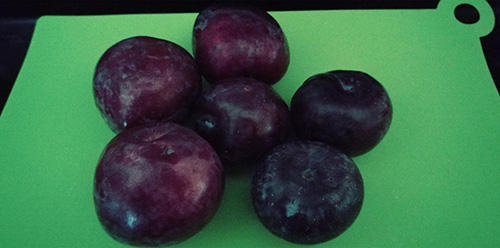 Varieties such as freestone plums tend to be easier to work with because the skin will pull away easier than other varieties, such as clingstone.
Varieties such as freestone plums tend to be easier to work with because the skin will pull away easier than other varieties, such as clingstone.
Related: 50 Foods to Dehydrate for Your Stockpile
Preparing the Plums
It’s not a difficult process, but each step listed here is important and necessary. So, make sure to follow the directions and not skip any steps.
#1. The first step is washing the plums, and removing all stems or remnants.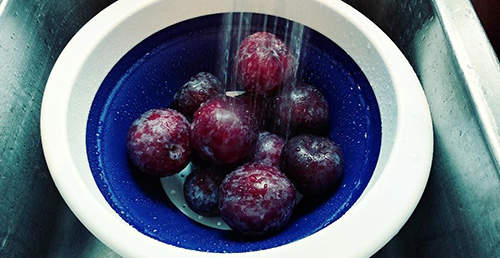 #2. Using a knife, cut the plum in half by cutting down to the pit, going around the circumference of the plum.
#2. Using a knife, cut the plum in half by cutting down to the pit, going around the circumference of the plum.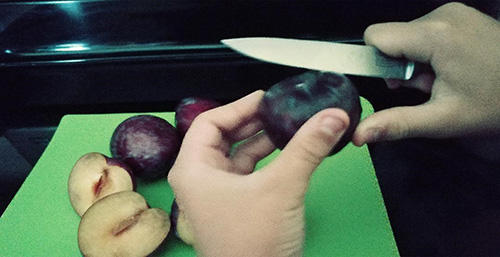 #3. With two hands on the plum, gently twist the plum with each hand going in the opposite direction, until it opens to 2 halves.
#3. With two hands on the plum, gently twist the plum with each hand going in the opposite direction, until it opens to 2 halves.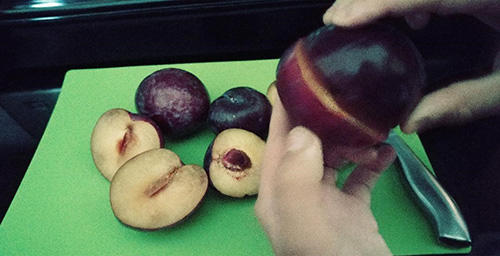 #4. Remove the pit. If it doesn’t come out right away, you can use the tip of the knife to edge it out.
#4. Remove the pit. If it doesn’t come out right away, you can use the tip of the knife to edge it out.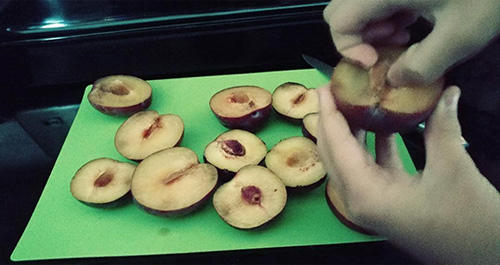 #5. Slice the plums to your desired size. They can be dried in halves, quartered, or chunked.
#5. Slice the plums to your desired size. They can be dried in halves, quartered, or chunked.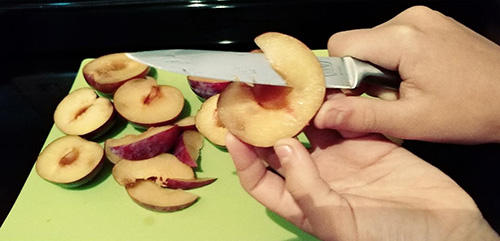 #6. Layer the pieces on a rack, and place in the oven or dehydrator set on 135 degrees. See the timing suggestions in the “Drying Methods” section.
#6. Layer the pieces on a rack, and place in the oven or dehydrator set on 135 degrees. See the timing suggestions in the “Drying Methods” section.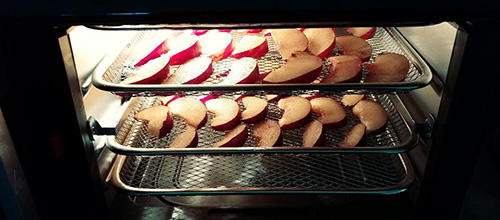
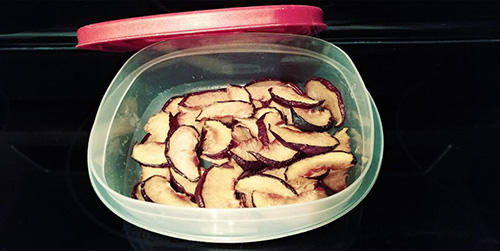 Drying Methods
Drying Methods
When it comes to the drying process there are three options to choose from, and your choice will depend on what you have available to use.
#1. Convection Oven or Dehydrator
Turn the oven or dehydrator up to 135 degrees. If drying halves or quarters position the pieces on a tray or rack, starting with the cut side facing up. After the cut side no longer looks moist, flip the pieces to expose the other side.
Timing depends on how you sliced the plums. Quarters, chunks, or slices typically take anywhere from 8 to 12 hours, halves 12 to 18 hours, and whole plums could take up to 36 hours.
#2. Conventional Oven
With a conventional oven halves and whole plums are not recommended, because it takes much longer than convection ovens.
Turn the oven to 135 degrees, and place the pieces on a tray or screen. The pieces should be rearranged every few hours during the drying process, which could take anywhere from 8 to 18 hours.
#3. Sun-drying
For those of you who live in sunny areas you might consider the sun-drying process. It’s done in the same manner as in the ovens, but takes much longer. Quarters, chunks, or slices will probably take 2 to 3 days, halves taking 3 to 4 days, and whole plums taking up to 5 days.
Note: some electric ovens will not allow to go as low as 135 degrees. Mine doesn’t, so I used a dehydrator instead.
You will know they are done when they feel somewhat springy to the touch, and show no signs of moisture in the thickest part. Also, they will be darker than fresh plums, including the skins.
How to Use Dried Plums
Dried plums provide a sweet-tart flavor, and the texture is chewy. You can enjoy them as is for a snack, or add them to a recipe, and use them to replace prunes in some recipes.
They might also be rehydrated by using a hot-soak in water, completely covered by about an inch, for up to 2 hours. Or, you could also use a cold-soak overnight.
The shelf life for dried plums depends on how they are stored. The following is a guide:
- Pantry – 6 to 12 months
- Refrigerated – 1 to 2 years
- Freezer – Indefinite
Whatever method you prefer to store your dried plums, make sure they are in an airtight container.
Don’t let this tasty treat stop with your generation. Pass it on to the next!
You may also like:
How to Grow Fruit All Year Round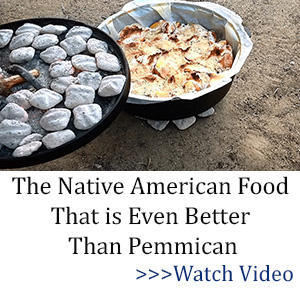
World’s Smallest Battery Powers House For 2 Days (Video)
How do You Keep Your Pantry Dry to Prevent Your Food from Spoiling?
7 Super Cheap Foods To Stockpile That People Usually Throw Away

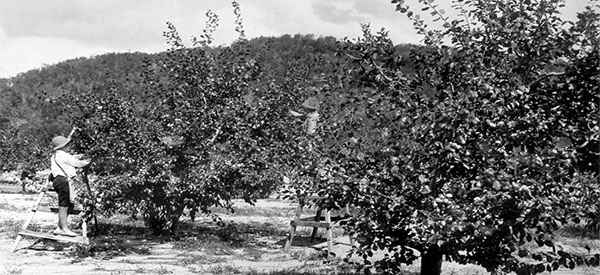













When using an oven to dehydrate, prop the oven door open just a crack to allow the moisture to escape. Otherwise you are only warming your fruit and it will get mushy and not dehydrate properly. Learned this one the hard way.
First of all I canned with my Mother, and she canned because the food taste a lot better than the canned food in the stores. Wrap really green tomatoes in newspapers so they will be ripe by thanksgiving & Christmas, keep in dark place, this was why we canned and food was cheaper to by from farmers.
Aren’t dried plums called prunes?
I know the marketing wonks for the plum industry have decreed that prunes are to be called dried plums which, perhaps is a more descriptive term for the product but we have a single word that tells us what it is. Why use two words?
I have often wondered where prune juice comes from. Since prunes are dried plums they have no juice. Would it be more accurately labeled plum juice?
Prune juice is made from prunes blended with water until it’s a suspension. That’s why, if you read the label, prune juice has fiber in it. You can make it yourself in a blender if you want to, but I would cook the prunes first to soften them and make them process easier.
Lemon juice is often added to cut the rather cloying sweetness. If you mix it with lemon juice and vodka, you have a drink known as a Piledriver.
Long-term storage just like grandma? Wait a minute. You are storing grandma longterm?
After my grandmother passed away, I ended up with the “cremains.” Not knowing exactly what to do with them since I didn’t live anywhere near her, they went into storage where they remain to this day, 25 years, 3 moves and about 3500 miles later. When I saw the title of this article, that is precisely the picture that entered my brain.
I REALLY need to do something with Grandma but have no desire to go back to the east coast these days.
Don’t mean to show my ignorance, but what qualifies as an airtight container? Are you talking ziplock bag, seal-a-meal, a jar that has been run through the dishwasher?
Lived in Silicon Valley before the Silicon. What was there were orchards, cherries, plums, apricots and walnut.
We had actually two types of plums. One the type you eat off the tree. The others were incredibly high in sugar. You could actually see what looked like sugar crystals. These were what we’re made into prunes. I’ve not seen these trees in years.
It’s really sad what technology and building more and more subdivisions has taken away from us. Growing up on a small farm we had fresh veggies and meat all year long. Big chain stores have closed down mom and pop stores. Which has taken away all the home grown food we use to get.